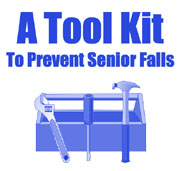|
|
 |
 A Tool
Kit to Prevent Senior Falls: A Tool
Kit to Prevent Senior Falls:
Falls and Hip Fractures Among Older Adults:
CDC Activities
Programs
- Remembering When: A fire and falls prevention program for older adults
In October 2000, CDC began funding state health departments in Arkansas, Maryland, Minnesota, North Carolina, and Virginia to implement and evaluate a program to teach older adults how to prevent fires and falls. Remembering When: A Fire and Fall Prevention Program for Older Adults is a curriculum developed by the National Fire Protection Association, CDC, the U.S. Consumer Product Safety Commission, and other partners. This program uses lesson plans, brochures, fact sheets, game cards, and other educational materials to present 16 life-saving lessons developed for older adults. It is the first program of its kind to educate older adults about both fire- and fall-related injury prevention, and is one of the few off-the-shelf programs available for communities to use for this purpose.
In August 2002, Georgia State University was awarded a cooperative agreement to perform an in-depth evaluation of the effectiveness of this program to assess its ability to improve the knowledge and skills of older adults to prevent fires and falls. Evaluation results will be used by CDC to make informed decisions about future support and how to disseminate the program.
- Tool Kit to Prevent Senior Falls
CDC researchers have developed The Tool Kit to Prevent Senior Falls, a comprehensive collection of fall prevention materials for health professionals. The Tool Kit, originally published in 1999, contains fact sheets, health education materials, and a home assessment checklist designed to reduce falls and related injuries among older adults. Materials are based on the published literature and research conducted and sponsored by CDC since the late 1980s. The Tool Kit materials are in both English and Spanish and are only available online. More than 6,000 recipients have requested materials from the Tool Kit for fall prevention programs. Tool kits have been distributed to clients at senior centers, hospitals, and health departments. The materials have also been used in professional presentations and for teaching nursing and health care
students.
Research
- No More Falls! A Multifaceted Program to Prevent Falls
CDC funds the California State Health Department in a cooperative agreement to study the effectiveness of “No More Falls!” a community-based fall prevention program for independently-living older adults in a community. The overall goal of this study is to demonstrate the value of integrating fall prevention into existing community-based public health programs for older adults. The study has been implemented among 552 seniors attending Preventive Health Care for the Aging clinics in two counties: urban San Diego county and rural Humboldt county. The intervention includes four elements: education about fall risk factors, exercise to increase strength and balance, medication review, and home assessment and modification. The goal of the intervention is to reduce incidence of falls requiring hospitalization by 10%. Results of the study, which are expected to be completed by October 2004, will help guide future efforts to develop multifaceted fall prevention programs.
- Dane County SAFE Study Research Project
While we know that multi-component interventions have been successful in reducing falls among high-risk older adults, few studies have addressed how such approaches can be practically and effectively applied within existing community structures. In October 2002, CDC funded the Wisconsin Department of Health, in collaboration with the University of Wisconsin, to conduct a randomized controlled trial to assess the effectiveness of a comprehensive approach to preventing falls among adults ages 65 and older at high risk for falls. This project will use two complementary strategies: a comprehensive at-home assessment followed by risk reductions, and a broad-based program to engage and educate service agencies and health providers.
The intervention involves two components: identifying predisposing fall risk factors through a comprehensive
assessment and facilitating risk reduction through changes in medical condition, vision, medications, behavior, physical functioning, home environment, and social support. The intervention will include participation in existing exercise classes that have been certified by the project, and will also link participants to existing medical care and human service networks. After one year of participation in the intervention group, a 40% decrease in fall rates are expected. Other expected outcomes include decreased hospital and nursing home stays, improved physical function, and a decreased fear of falling. The study is expected to be completed in August 2005.
|
